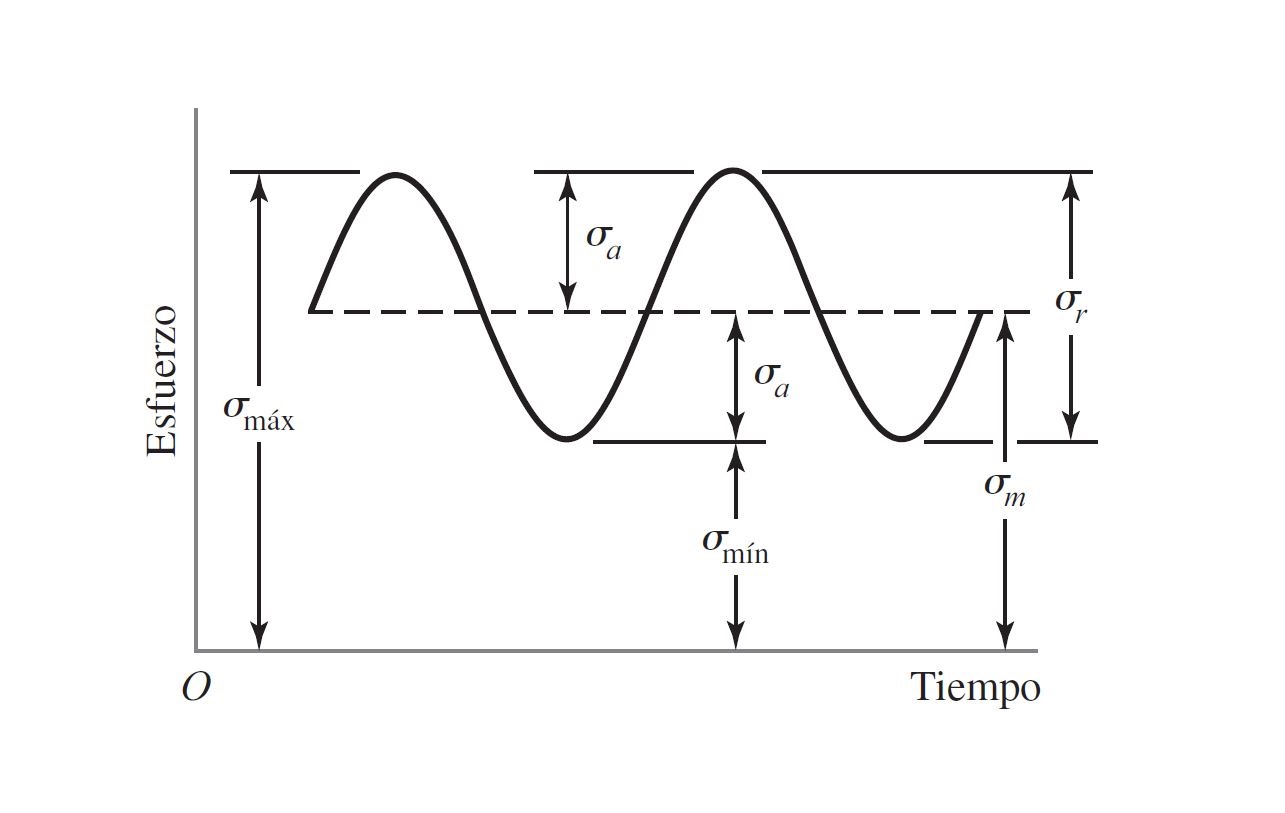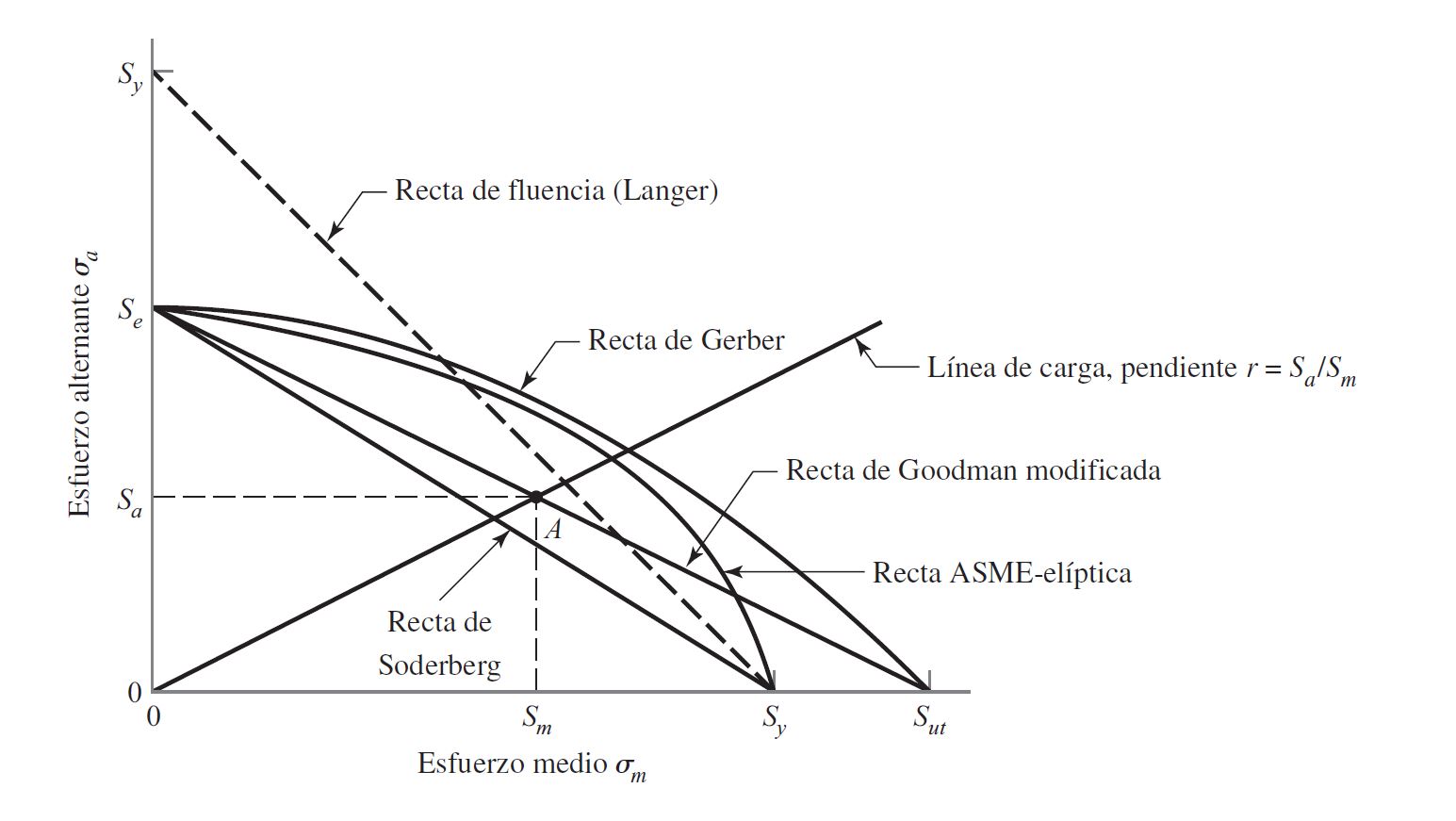Fatigue
fluctuating stresses; yet the most careful analysis reveals that the actual maximum
stresses were well below the ultimate strength of the material, and quite frequently even
below the yield strength. The most distinguishing characteristic of these failures is that
the stresses have been repeated a very large number of times. Hence this failure is called
a fatigue failure.
In this section, we will focus on fatigue calculation by means of the stress-life method, which tries to extrapolate the results obtained from laboratory tests to components in real applications. It should be taken into account that although this method has traditionally been used in engineering, it is not the most accurate, so the calculations obtained should be considered as an approximation of the behavior in reality. The only way to know exactly the fatigue performance of an element is to test it under the cyclic loads to which it will be subjected. The formulation presented in these sections refers to ferrous materials (steels) which are known to have an infinite life at high numbers of cycles ( 10^6 ) for a given load. This is not the case for other materials such as aluminum, which always undergoes a downward curve, so that a fatigue load value is usually given for 5\cdot10^8 cycles.
The Endurace Limit (Se)
According to different steel tests, the endurance limit ( S_e' ) can be estimated through the ultimate tensile strength ( S_{ut} ) as follows:
S_e' = \begin{cases} 0.5 S_{ut} &\text{si } S_{ut} \le 200 kpsi \\ 100 kpsi & \text{si } S_{ut} > 200 kpsi \end{cases}
S_e = k_a \cdot k_b \cdot k_c \cdot k_d \cdot k_e \cdot k_f \cdot S_e'
Surface factor (ka)
k_a = a S_{ut}^b
| Surface finish (Acabado superficial) | Factor a | Exponent b |
|---|---|---|
| Ground (Esmerilado) | 1.34 | -0.085 |
| Machined (Mecanizado) | 2.70 | -0.265 |
| Cold-drawn (Laminado en frio) | 2.70 | -0.265 |
| Hot-rolled (Laminado en caliente) | 14.4 | -0.718 |
| As-forged (Forja) | 39.9 | -0.995 |
Size factor (kb)
k_b = \begin{cases} 0.879d^{-0.107} &\text{para } 0.11 \le d \le 2 in \\ 0.91d^{-0.157} & \text{para } 2 < d \le 10 in \end{cases}
k_b = 1
A_{0.95\sigma} = \Large \frac {\pi}{4} \normalsize [d^21 - (0.95d)^2] = 0.0766d^2 = 0.0766d_e^2
| Sección | A0.95σ | de |
|---|---|---|
| Circular o anular estática de diámetro d | 0.01046d² | 0.370d |
| Rectangular maciza o hueca rotativa de lados b x h | 0.0975hb | 1.128(hb)^(½) |
| Rectangular maciza o hueca estática de lados b x h | 0.05hb | 0.808(hb)^(½) |
Loading factor (kc)
k_c = \begin{cases} 1 &\text{flexión } \\ 0.85 & \text{axial } \\ 0.59 & \text{torsión } \end{cases}
Temperature factor (kd)
possibility and should be investigated first. When the operating temperatures are higher
than room temperature, yielding should be investigated first because the yield
strength drops off so rapidly with temperature.
k_d = \small 0.975 + 0.432\cdot 10^{-3} T_F - 0.115\cdot 10^{-5} T_F^2 + 0.104\cdot 10^{-8} T_F^3 - 0.595\cdot 10^{-12} T_F^4
For 70 ≤ T_F ≤ 1000 ºF
Reliability factor (ke)
| Confiabilidad (%) | ke |
|---|---|
| 50 | 1 |
| 90 | 0.897 |
| 95 | 0.868 |
| 99 | 0.814 |
| 99.9 | 0.753 |
| 99.99 | 0.702 |
| 99.999 | 0.659 |
| 99.9999 | 0.620 |
Miscellaneous-Effects factor (kf)
Chart S-N

With the SAE approach for steel with H_B \le 500:
\sigma_F' = S_{ut} + 50 kpsi
And with “b”:
c = - \Large \frac {log (\sigma_F' / S_{e}')}{log (2\cdot 10^6)}
Where S_e' is the endurance limit without modifications.
Stress Concentration (Kf)
K_f = 1+ \Large \frac {K_t - 1}{1 + \frac{\sqrt{a}}{\sqrt{r}}}
Where \sqrt {a} is Neuber constant whose value for bending and axial stresses is:
\sqrt{a} = 0.246 - 3.08 \cdot 10^{-3} S_{ut} + 1.51 \cdot 10^{-5} S_{ut}^2 - 2.67 \cdot 10^{-8} S_{ut}^3
And for torsional stress:
\sqrt{a} = 0.190 - 2.51 \cdot 10^{-3} S_{ut} + 1.35 \cdot 10^{-5} S_{ut}^2 - 2.67 \cdot 10^{-8} S_{ut}^3
Where the equations apply to steel, S_{ut} is in kpsi and “r” is the notch radius in inches (in).
Fluctuating Stresses

\sigma_{min} = minimum stress
\sigma_{max} = maximum stress
\sigma_{m} = midrange component
\sigma_{a} = amplitude component
\sigma_{r} = range of stress
\sigma_m = \Large \frac {\sigma_{max} + \sigma_{min}}{2}
\sigma_a = \Large | \frac {\sigma_{max} - \sigma_{min}}{2}|
Fatigue failure criteria

Soderberg
\Large \frac{S_a}{S_e}\normalsize + \Large \frac{S_m}{S_y} \normalsize = 1
Mod-Goodman
\Large \frac{S_a}{S_e}\normalsize + \Large \frac{S_m}{S_{ut}} \normalsize = 1
Gerber
\Large \frac{S_a}{S_e}\normalsize + \Large (\frac{S_m}{S_{ut}})\normalsize^2 = 1
ASME-elíptica
\Large (\frac{S_a}{S_e})\normalsize^2 + \Large (\frac{S_m}{S_y})\normalsize^2 = 1
Langer static yield
S_a+ S_m = S_y
Failure criteria are used together with the load line r = S_a/S_m = \sigma_a/\sigma_m .
Gerber
S_a = \Large \frac{r^2S_{ut}^2}{2S_e} \left [\normalsize-1+\sqrt{1+ \left(\Large \frac{2S_e}{r S_{ut}} \right)^2} \right]
S_m = \Large \frac{S_a}{r}
n_f = \Large \frac{1}{2} \normalsize \left( \Large \frac{S_{ut}}{S_m} \right)^2 \Large \frac{S_{a}}{S_e} \normalsize \left[ -1+\sqrt{1+ \left(\Large \frac{2 S_m S_e}{S_a S_{ut}}\right)^2}\right]
ASME-elíptica
S_a = \sqrt{\Large \frac{r^2 S_e^2 S_y^2 }{S_e^2 + r^2 S_y^2}}
S_m = \Large \frac{S_a}{r}
n_f = \sqrt{\Large \frac{1}{(S_a / S_e)^2 + (S_m / S_y)^2}}
Varying and fluctuating stresses

| nº cycle | σmax | σmin | σa | σm | r = σa/σm |
|---|---|---|---|---|---|
| 1 | 80 | -60 | 70 | 10 | 7 |
| 2 | 60 | 40 | 10 | 50 | 0.2 |
| 3 | -20 | -40 | 10 | -30 | -0.333 |
D = \sum_{i=1}^n N_{eq} \left(\Large \frac{1}{n_i} \right)
Load Combinations
When axial, bending and torsional forces are present, Von Mises stress is calculated for \sigma_{m}' and \sigma_{a}' as follows:
\sigma_m' = \sqrt{ \left[ (K_f)_{fl} (\sigma_m)_{fl} + (K_f)_{ax} (\sigma_m)_{ax} \right]^2 +3 \left[ (K_f)_{tor} (\tau_m)_{tor} \right]^2 }
\sigma_a' = \sqrt{ \left[ (K_f)_{fl} (\sigma_a)_{fl} + (K_f)_{ax} (\sigma_a)_{ax} \right]^2 +3 \left[ (K_f)_{tor} (\tau_a)_{tor} \right]^2 }
Once Von Mises stresses \sigma_{m}' and \sigma_{a}' have been calculated, they can be entered into the fatigue criteria already defined:
can be found by expressing each component in trigonometric terms, using phase angles,
and then finding the sum. If two or more stress components have differing frequencies,
the problem is difficult; one solution is to assume that the two (or more) components
often reach an in-phase condition, so that their magnitudes are additive
Accumulated Damage
The example chart shows the S-N curve of a component (continuous curve) and its modification (dashed curve) after application of a reversed load of \sigma_1 = 60 kpsi with a number of cycles of 3 \cdot 10^3.

Since insufficient numbers of cycles ( N_1 ) occur to produce fatigue damage, the component can still resist fatigue but its curve must be modified since it has accumulated the damage from the described loading.
For this purpose, a new descending line is drawn through the point (N_1-n_1, \sigma_1) to the new endurance limit S_{e,1}' at 10^6 cycles.
This modification changes the endurance limit level of the component so that it is no longer able to withstand the same load at infinite time.






